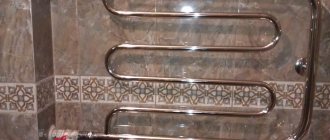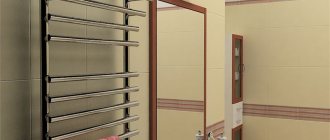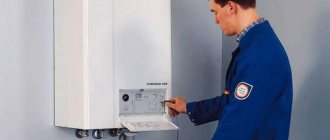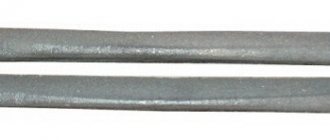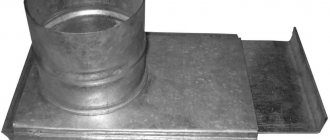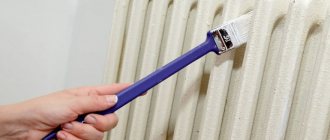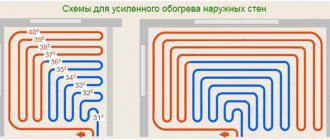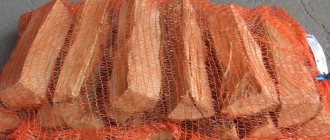A heated towel rail is a special device for drying towels. The device is installed in the bathroom and allows you not to worry about the safety of your bath accessories. Towels left wet for a long time deteriorate and quickly lose their strength, and can also become a source of an unpleasant musty odor. Constantly drying on the balcony and washing is also quite tiring. To solve this problem, most people decide to install a heated towel rail. Another reason for installing the device is that during the cold season it does an excellent job of heating the room. You can hang not only towels, but also other small items on the device. The diversity of the model range allows you to choose the optimal heated towel rail model.
What criteria must be taken into account when choosing a heated towel rail?
The device can be powered by electricity or water. The latter operate on the principle of heating radiators. Electric models are easy to connect, but require good, working electrical wiring. The preferred connection method must be taken into account when purchasing. Water ones are more common because they are considered as safe as possible and can be installed even in houses and apartments with old electrical wiring. Deciding on the connection method is not difficult. It is much more difficult to choose the right shape and dimensions of the heated towel rail. The dimensions of the device must be selected taking into account the area of the room, since it takes on the “responsibilities” of a heating device.
Connection methods
If your choice is a water heated towel rail, then you should pay attention to the connection method, which comes in 3 types:
- Direct - the method used most often, suitable for ladders and coils.
- Bottom - used for large ladders, but requires good coolant pressure.
- Diagonal - suitable for large heated towel rails, provides effective heat transfer from the coolant, but requires a longer pipe length.
Main sizes of heated towel rails for bathrooms
Plumbing fixtures are produced by many manufacturers. Heated towel rails differ from each other not only in shape, but also in diameter:
- “¾” with an outer diameter of 2.5 cm. Such models most often have a U- or M-shape. Finding a heated towel rail of this size in a different configuration is quite difficult.
- “1” with an outer diameter of 3.2 cm. They are most widespread. Devices of this type are usually installed in the bathrooms of apartments and houses. They have a classic appearance and shape. There are models with a ladder and with dryers in the shape of the letter F, as well as foxtrots.
- “1 ¼” with the largest diameter equal to 4 cm. They are represented mainly by U-shaped devices. They are not widely used and are rarely found in stores. This is due to the fact that the production process requires the use of large diameter pipes.
The first two options can be found in the line of almost any manufacturer of plumbing equipment and the choice, as a rule, comes down to these models.
Types of heated towel rails
Types
There are two main types of heated towel rails:
- Water - they are connected directly to the hot water supply system.
- Electric - as their name implies, such heated towel rails are connected to the electrical network.
When choosing a heated towel rail for the bathroom, you should pay attention not only to the type of device, but also to factors such as the size of the heated towel rail, as well as the area of the heated room.
Forms
Heated towel rails also vary in shape. At its core, this device is a curved pipe that can have a variety of shapes. The most common forms are:
- U-shaped coils are similar to the letter P rotated 90°.
- M-shaped coils are similar to the letter M rotated 90°.
- Ladder - similar to a ladder.
- Foxtrot is a combination of two coils: an external U-shaped one and another internal one.
Foxtrots and ladders have a large heating area, which allows them to easily heat a fairly large room; in addition, they can accommodate more things to dry and dry faster due to the greater adherence of the fabric to the heated towel rail.
You can find out the corner dimensions of bathtubs in this article. And here about the sizes of cast iron bathtubs.
Material
The material from which heated towel rails are made is no less important; let’s take a closer look at them:
Steel
You won’t find such heated towel rails on sale, but in old houses, and even in some new ones, heated towel rails are simply made from an ordinary curved steel pipe. Their advantage is that they are cheap, and in addition, as practice shows, they work for years.
Stainless steel
They can withstand high pressure, are heavy, and come in chrome plated or painted in various colors. When choosing, be sure to look at the thickness of the pipe walls; they should be at least 3 mm.
Copper
High thermal conductivity, anti-corrosion resistance, lightness, appearance. When purchasing, please note that the inner surface of the pipe walls must be galvanized to maximize the protection of the pipe from water.
Brass
They have the advantages of copper heated towel rails; they are cheaper, but more fragile. When purchasing, choose heated towel rails with chrome-plated inner walls. They can be recommended for installation in autonomous heating systems.
How to correctly take into account the connecting size of the device?
Individual construction allows you to install a pipeline to connect a heated towel rail of the desired shape. In apartments, this option requires significant financial investments, but is often practiced when carrying out major renovations. The size directly depends on the shape of the device.
The most widespread are universal heated towel rails in the form of a coil, since they are manufactured according to generally accepted connection standards. Ladders and foxtrots also have close to standard parameters, which is why they are popular among consumers. When choosing a standard size, you should take into account such a parameter as the “conditional bore diameter” or the internal net size of the pipeline. It is always one size smaller than what is indicated in the classification. If you take a model with a connection of type “1”, the nominal diameter is “3/4”. This must be taken into account. Otherwise, you may encounter the fact that the purchased heated towel rail will not fit the pipeline.
Materials
It is clear that the cheaper the raw materials for production, the more benefits the manufacturer will receive. But the buyer of the coil is interested in the pipe radiator serving faithfully for a long time, without breakdowns. Therefore, in construction hypermarkets you can find heated towel rails made from the following materials:
- Stainless steel. Stainless steel is not susceptible to corrosion and is not susceptible to oxidation. Resistant to pressure changes.
- Carbon steel. Ordinary metal that rusts. It is coated with anticorrosive inside and outside. But this doesn't always help.
- Copper. Hot water can cause oxidation of internal surfaces. It is better to choose galvanized options.
- Brass. An alloy of copper with zinc, tin and iron. Must be chrome plated on the inside. Otherwise, water will damage the material.
Carbon steel coils are the least expensive. But the low price tag adds problems in the form of corrosion and leaks.
How to determine the size of a product?
The size of the heated towel rail plays a decisive role in the choice of equipment. If you incorrectly calculate the dimensions, this will complicate installation and will not allow you to purchase equipment that will fully cope with the functions assigned to it. Experts advise taking into account the temperature of the coolant in the system. It is usually 70 degrees. This technology assumes that the ratio of the heated towel rail area to the bathroom area is 2.5 cubic meters/100 W. In addition, be sure to determine the installation location and add 10 centimeters on each side.
Electric heated towel rail TERMINUS Victoria P7 450×750 electric with thermostat
- fast heating;
- full set;
- with thermostat.
A modern electrical appliance in the form of a ladder with seven rungs is made of high-quality stainless steel. Dimensions – 75×48.2 cm, center distance – 45 cm. Connects to a 220 V electrical wire with a hidden plug, which can be located below or on the right side.
The power of the electrical appliance is 103 W. It heats up to a maximum of 65 degrees – it is impossible to get burned on the walls. Conveniently, the device can be turned off at any time by pressing a button. Equipped with a thermostat that prevents the heated towel rail from overheating, as well as an LED indicator. Manufacturer's warranty – 2 years. The set includes four telescope mounts, a cable-to-plug connection, a hidden connection module, and instructions. Costs from 6000 rubles.
We can recommend it to those who are looking for a high-quality electric heated towel rail.
Owners note that the electrical appliance quickly heats up to the desired temperature. This indicator can be adjusted smoothly. The kit contains everything you need for installation.
Pros:
- material – durable stainless steel;
- turning on and off at any time;
- smooth temperature control;
- led indicator.
Shape and dimensions
Inextricably linked with each other. Dimensions directly affect the efficiency of the device and largely determine the aesthetic appeal of the bathroom:
- Foxtrots . Fits well into the design of absolutely any bathroom. They are available in widths from 40 to 80, and heights from 32 to 60 cm. This allows you to choose the most optimal option for both small and medium-sized bathrooms.
- M-shaped . They are distinguished by an original stylish external design. They have a rather impressive height, which varies between 50-60, which should be taken into account when purchasing. The width is standard, that is, 40-80 cm.
- U-shaped . They are the most compact models of heated towel rails. They are most often installed by developers in modern new buildings. Their height, as a rule, does not exceed 32 centimeters, and the width of the device is standard.
- Ladders . They are the largest. They have a standard width. The height of the device starts from 50 and ends at 120 centimeters. Thus, this type of heated towel rail takes up quite a lot of space.
The choice depends on the size of the bathroom and the buyer’s own preferences.
dimensions
The overall dimensions of household heating devices for the bathroom depend on the parameters of the room where they will be installed. At the same time, there is a special scale depending on the size of heated towel rails and the heating area of the room. For a standard bathroom with an area of 4.5-5 m2, a device with dimensions of 500x500 mm corresponds. At the same time, the overall dimensions of heating devices affect the amount of laundry that can be placed for drying.
The overall dimensions of the heated towel rail affect, first of all, the amount of laundry that can be hung on it
Bathroom area
Heated towel rails are only conditionally designed for drying bath accessories. In winter, these devices serve to heat the room. In order for the device to cope with this task, you should listen to the advice of experts and select a size commensurate with the bathroom:
- from 4.5 to 6 cu. m requires models 50x40, 50x50 and 50x60 cm;
- from 6 to 8 cu. m requires installation of a heated towel rail 60x40, 60x50 or 60x60 cm;
- from 7.5 to 11 cubic meters. m needs a device of the following dimensions: 80x40, 80x50, 80x60 cm;
- from 10 to 14 cubic meters m, the best option would be a model with a size of 100x40, 1000x50 or 100x60 cm;
If the bathroom has a large area, you should purchase and install a large model with a height of 120 cm. Otherwise, the room will not warm up properly. The largest model should only be taken into a spacious bathroom. It will clutter up a room with a small to medium area, and the heat generated will be excessive.
Additional equipment functions
Modern electric heated towel rails are energy-efficient devices that are beneficial to leave on at all times. This is due to the fact that heating an initially cold radiator will require a temperature significantly higher than that required to maintain the heat of an already heated device.
Manufacturers, taking into account the wishes of all consumers, have developed models of drying devices equipped with shut-off switches and timers. Progressive models allow you to achieve the set temperature without outside intervention
The presence of a timer allows you to set a program for turning on the water heated towel rail before taking a shower or bath. This will keep the towel warm when you need it.
Switches and timers can be built-in or act as a convenient separate option. Some models are equipped with a thermostat to maintain the required temperature of the device according to your wishes.
You will learn about the rules and wiring diagrams for electrical “drying” by reading the popular article on our website.
General recommendations for choosing a heated towel rail
To select a plumbing fixture that will fully meet the assigned functions, the following criteria should be taken into account:
- fastening method;
- material of manufacture;
- connection size and shape of the heated towel rail;
- the size of the bathroom and the location where the device is planned to be installed.
It is impossible to single out any specific version of the heated towel rail. The choice must be made on an individual basis. Many criteria should be taken into account, including the sufficient amount of heat generated by the device. Otherwise, it will not be possible to heat the room. Another important nuance is the weight of the heated towel rail. A plasterboard wall, for example, cannot withstand any load. To avoid force majeure situations, they calculate not only the optimal size, but also the weight of the future plumbing fixture. There is no need to calculate this parameter yourself. Weight is indicated in the accompanying documentation.
Conclusions and useful video on the topic
The video will clearly introduce the main aspects of the choice:
We tried to give you a general idea about water heated towel rails that will help you choose the optimal model. Taking into account the material of manufacture, the degree of resistance of the product to corrosion processes, technical characteristics and features of the devices, you will be able to choose the optimal model of heated towel rail.
Would you like to tell us how you chose a heated towel rail for your own bathroom? Did you have any questions while reading the article? Do you want to provide interesting information? Please leave comments in the block below.
Summarizing
You cannot purchase a heated towel rail solely based on individual preferences. The device should not only keep towels dry, but also heat the room. Choosing the wrong size will result in the bathroom simply not warming up properly. The aesthetic component is also important. You should never rush into a purchase. They always pre-measure the location of future installation and calculate the optimal size. In addition, you should pay attention to the protection class, which is indicated in the passport for the heated towel rail. Experts recommend choosing models whose indicators are 22 and 24. The first number means protection from damage, and the second from moisture.
Installation steps
If the task is to replace an old device, then first you need to remove it, which is done very simply. The first step is to turn off the water and unscrew all the fastening nuts through which the device is connected to the water pipes
Then carefully remove the fasteners and device from the wall
Once the dismantling work is completed, you can remove the new device from the box and begin installation. Holders are attached to the new model and connections are screwed through which water will be supplied. Next, the structure is placed against the wall, and the necessary marks are made with a pencil.
The next step is to drill all the holes in the tiles and insert dowels into them. It is better to use plastic products as fasteners. After making sure that the device is located correctly, all that remains is to fix it on the wall and connect it to the general piping system or central heating.
It is important to note that many bathroom coil manufacturers, as well as their distributors or retail outlets, offer a range of installation services. In this case, the task is performed by a specialist, and the consumer is provided with a full guarantee for installation work
When purchasing a new device, it is better to take advantage of this opportunity, as this will avoid many troubles in the future. But if independent installation does not seem incredibly difficult, then it is quite possible to implement it on your own.
What is the center distance of a heated towel rail?
The service life of a high-quality heated towel rail is more than 15 years. And therefore, for a retail consumer, this is exactly the kind of purchase that is made once and for a long time. And this is quite possible if the heated towel rail is purchased of high quality and installed professionally. To enjoy the warmth and comfort in your bathroom for a long time, the manufacturer of heated towel rails talks about how to make the right choice of heated towel rails in general and NIKA in particular in 5 steps.
/The enlarged diagram is below, after the text description/
Step 1. Decide on the size of the heated towel rail.
Finding out the limitations on overall dimensions and center distance are, perhaps, the main technical parameters with which to start selecting a heated towel rail. The first step is to take measurements of the walls and determine the possible or desired overall height, width and “depth” of the device. The center-to-center distance (that is, the distance between the connection axes of the heated towel rail) is the most important parameter when ordering a water heated towel rail. It is measured from the center of one to the center of another pipe connecting to the water.
Do you want to take a heated towel rail instead of the one that was already installed?
Remove from it the interaxial dimensions of the water outlet (for a water one) or the size between the centers of the holes in the tile where you plan to mount the heated towel rail (for an electric one).
Does the bathroom already have a water outlet for a water heated towel rail?
Measure the distance between the terminals, this will be the center-to-center size of the water heated towel rail.
Still designing a bathroom?
Then there are minimal restrictions, you can choose almost any option you like, and then plan the water output or electricity supply specifically for it.
Almost every collection of NIKA heated towel rails in the form of “Ladder” is available in fifteen standard sizes: five heights (50, 60, 80, 100 and 120 cm) and three widths (60, 50 and 40 cm). The buyer is given the opportunity to choose any combination of these parameters. The most popular size is 80/50 cm, where 80 is the height and 50 is the width of the product between the axes. If only these two parameters are indicated, then the overall dimensions of water heated towel rails will be plus 3 cm to the center distance in height and 6 cm in width; and electric ones - plus 7 in width. If a model has three parameters, then they also contain overall width dimensions, for example, 80/10/70 - center height 80 cm, center connection width 10 cm, overall width 70 cm. There is also one more parameter - overall “depth” » products - that is, at what distance from the wall the outermost bars of the heated towel rail will be located. This parameter is especially relevant for a heated towel rail with a top shelf, usually protruding approximately 27 cm from the wall.
It is important to remember that not only its appearance and functionality depend on the size of the model (the higher the heated towel rail, the more horizontal jumpers it has), but also its heat transfer (the larger the size, the greater the heat transfer). It is recommended to compare the heat transfer parameters with the area of the room in which the heated towel rail will be installed; usually, manufacturers indicate these parameters in their catalogs.
Step 2. Select the type of heated towel rail.
Almost any NIKA heated towel rail of the “Ladder” type can be manufactured in both water and electric versions.
How to decide - water or electric?
If you have or plan to remove water, it is logical to use a water one.
If there is no water supply and is not planned - electric.
If the previous water heated towel rail corroded, gave an electric shock, or leaked at the wrong connections, you need to take care of grounding the heated towel rail, or use an electric one.
Electrical requires hidden wiring or a socket located in strict accordance with the manufacturer's recommendations on the left or right side of the heated towel rail.
Which heated towel rail is cheaper - water or electric?
In terms of purchase and operating costs, an electric heated towel rail model is more expensive than a similar water-type model. Also, when using an electric heated towel rail, you are charged for the electricity consumed, while a water heated towel rail is included in the hot water supply system of the house and does not require additional costs.
Step 3. Select a package
The choice of configuration fundamentally depends on the choice of the type of heated towel rail made in the previous step.
All NIKA water heated towel rails are equipped with two Mayevsky valves for air release, two fasteners to the wall and two eccentrics with reflectors. Therefore, at this stage you only need to select the fittings with which the heated towel rail will be connected to the water. For heated towel rails with internal threads, the “Lux” option (equipped with cross-shaped or barrel-shaped shut-off valves, which allows you to regulate the temperature of the heated towel rail by reducing or increasing the water flow inside it) and the “Standard” option (equipped with conventional corner fittings without adjustment) are suitable. (for heated towel rails. For dryers with external threads (“Economy” option) - fittings are selected as desired.
For electric heated towel rails, you need to choose the type of electric heater (heating element); the NIKA company uses three types of heating elements from the most popular Polish manufacturer THERMA.
How to choose a heating element for an electric heated towel rail?
The KTX-3 heating element has multi-stage temperature control and a multifunctional timer with programming capabilities.
The MEG heating element allows you to adjust the temperature using buttons in the range of 30°-60°C.
The MOA heating element gives you a choice of temperature, heating period and an automatic shutdown option.
When ordering TEN, it is important to indicate two more parameters. How will it be connected to the electrical network - through a socket (then a heating element with a plug is ordered) or through a hidden connection (wire and masking element for hidden installation). And from which side the connection will be made, left or right. By default, the heating element is installed on the right and is equipped with a wire and plug.
STEP 4: Select one of the processing options
Technical parameters and equipment
Heated towel rails vary in heat output. You need to choose a product for arranging a bathroom taking into account its size. To maintain the optimal temperature in the room, select a dryer so that for every 1 square meter there is 1.2-1.4 W of power.
Center-to-center is the distance between the centers of the inlets. When replacing a device, look for an option with the same values for this parameter. Otherwise, the eyeliner will have to be redone.
The diameter of the connection bends may not coincide with the indicator for pipes. Using the accessories, the device can be connected.
Contents may vary. Some devices are sold ready for connection. When purchasing others, you will have to purchase accessories separately. It is preferable to have a Mayevsky valve (to remove accumulated air), a thermostat, spare valves and taps.
